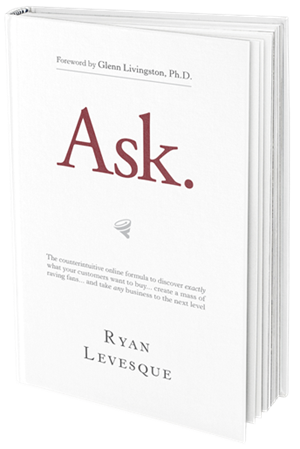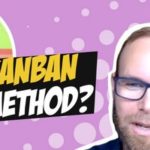Back when James was a salesperson, the core of his selling technique was Neil Rackham’s concept of SPIN Selling. This framework emphasizes the importance of identifying a customer's pain points through probing questions, then magnifying these challenges, and presenting a relevant solution as the logical next step.
This approach proved effective in selling high-volume vehicles and has become for James a foundational strategy for online sales.To delve deeper into the application of this technique in online marketing, James invites Ryan Levesque, an expert in online marketing and survey funnels, to share his insights.
Ryan shares his experience in applying the SPIN Selling technique to the digital landscape. Having generated over $100 million in sales across 23 markets, his adaptation of this sales process for online business has been highly successful.
In their talk, he discusses with James the methods that have enabled his team to achieve this success in the digital domain, making it accessible to a wider audience looking to enhance their online marketing strategies.
The talk also looks at Ryan's book, "Ask," which consolidates the principles and strategies discussed into a comprehensive guide. Ask aims to equip readers with a counterintuitive formula to uncover precisely what customers want to buy, thereby creating devoted fans and elevating any business to the next level.
Podcast: Download (Duration: 31:45 — 29.2MB)
Get Notified Of Future Episodes Apple Podcasts | Spotify | Amazon Music | Android | Blubrry | Gaana | TuneIn | Deezer | Anghami | RSS | More
Table of Contents
1. 3 important elements of the book
– Doing your market research without directly asking what people want
– Paying customers that will love your product / service
– The reward for your marketing efforts
2. How to set up a survey funnel
3. Easier solutions for online business owners
4. Learn more about the software
5. The benefit of survey segmentation
6. Methodology and action steps
– The deep dive survey
– Micro-committing
– The same visit sales letter
– Profit maximization
– Email feedback
7. Can your online business benefit from a survey funnel?
– One product, diverse audiences
– Multiple products, audience unsure which to choose
8. Action steps to take
9. Profitable and rewarding
Have James help you double your online business HERE
3 important elements of the book
The subtitle of Ryan’s book reads: “The counterintuitive online formula to discover exactly what your customers want to buy, create a mass of raving fans, and take any business to the next level.” He considers the three goals outlined to be all important.
1. Doing your market research without directly asking what people want
Market research is counterintuitive in nature, says Ryan. Direct questions about desires often fail because people may not truly know what they want. He references figures like Henry Ford and Steve Jobs, who understood that innovation doesn’t come from asking people directly but from presenting them with solutions they hadn’t imagined.
This approach calls for a nuanced way of inquiry that explores desires without directly querying them, laying groundwork for a deeper understanding of consumer needs.
2. Paying customers that will love your product / service
Ryan suggests cultivating a base of enthusiastic customers by engaging with them in a manner that’s both beneficial for the consumer and the merchant.
Instead of the aggressive, one-size-fits-all marketing tactics commonly seen online, Ryan proposes a more personalized approach. This involves taking time to understand the customer’s unique challenges and goals before recommending a solution, fostering goodwill and a more meaningful connection between the consumer and the seller.
3. The reward for your marketing efforts
The ultimate goal of this refined marketing strategy is to elevate any business to a new level of success and industry leadership.
Ryan shares his experience of applying this approach across various markets, resulting in significant sales and top market positions. This universal strategy, adaptable to any market or business model, promises transformative potential for the industry.
James can relate. He notes the stark contrast between traditional online marketing tactics and the more interactive, customer-focused approach enabled by modern technology. He can see how this strategy might achieve huge market success.
How to set up a survey funnel
Now how do we set things up to achieve this next level, asks James?
Ryan introduces a nuanced approach that begins with the landing page of a website. Rather than using a conventional squeeze page that aggressively demands contact data for a free report, Ryan suggests a more engaging method.
He illustrates this with an example from his memory improvement business, Rocket Memory, where visitors are greeted with a short video that offers to guide them to the most suitable course based on their responses to a brief survey.
The survey method is detailed further, demonstrating how it personalizes the customer’s journey. By asking a series of targeted questions about the visitor’s gender, age, and specific situation, Ryan’s approach tailors product recommendations to individual needs.
This process not only helps identify the best course for the visitor but also enhances the user experience by making it feel customized and considerate.
Upon completing the survey, visitors are prompted to provide their name and email to receive a customized report, transitioning into a lead generation tool.
Following this, they are presented with a video sales message tailored to their survey responses, aiming to convert them into customers by addressing their specific concerns and suggesting the most relevant course.
Ryan’s marketing philosophy, which values personalized engagement over one-size-fits-all solutions, resonates across various industries. It recognizes the uniqueness of each individual and their specific needs, making the marketing message more effective and relatable.
James acknowledges the appeal of seeing oneself reflected in marketing messages. This approach was quite rare when he first started online. Have technological advancements made such strategies more accessible to the everyday internet marketer?
Easier solutions for online business owners
A great question, says Ryan. His entry into personalized online marketing was born out of necessity after initial failures. He discovered the power of asking direct questions to his audience through a survey, specifically asking why they chose not to purchase.
This approach was prompted by a failed venture teaching people to make Scrabble tile jewelry. The results led Ryan to realize that his market was not homogenous, but consisted of distinct segments.
This insight marked the beginning of Ryan’s journey into market segmentation and personalized marketing.
As his methods evolved from basic segmentation attempts to more sophisticated strategies, Ryan ran into a lack of suitable tools to facilitate his approach. This gap in the market prompted him and his team to invest in the development of their own software solution, enabling them to efficiently segment their audience and tailor their marketing efforts across various markets.
Ryan’s bespoke tool became a cornerstone of their success in applying personalized marketing techniques on a larger scale.
Learn more about the software
Approximately a year and a half before this recording, Ryan and his team made their proprietary solution available as a commercial software product.
The software not only simplifies the survey segmentation process but also integrates seamlessly with various autoresponder programs, enhancing the customization and efficiency of marketing campaigns.
Users can funnel respondents into different email sequences based on their survey responses and push this data into the contact records across numerous platforms like Ontraport, InfusionSoft, Aweber, Constant Contact, and MailChimp, showcasing the software’s compatibility with any autoresponder system.
The benefit of survey segmentation
Ryan highlights the strategic advantage of collecting detailed information about prospects, such as gender and age, to enhance marketing efforts.
By segmenting email lists based on specific characteristics, marketers can target highly relevant offers to subsets of their audience – low testosterone products, for instance, to men in their 40s and 50s – thus increasing the profitability of their campaigns.
This approach underscores the value of capturing and utilizing granular data about prospects beyond just their names and emails.
James acknowledges the potential of Ryan’s segmentation strategy, which funnels people through questions to classify them into different “buckets.” Ryan’s manuscript, “Ask,” provides a practical overview of the methodology that James pronounces fantastic.
James notes the relevance of this approach to his own use of Ontraport, which facilitates advanced segmentation and customized sequences based on user interactions with his site.
Would Ryan care to discuss the specific steps involved in his methodology, as outlined in his book?
Methodology and action steps
Ryan stresses the importance of identifying, first of all, the optimal number of customer segments or “buckets” to effectively personalize marketing efforts. There’s a balance, he says, between excessive segmentation and a one-size-fits-all approach.
1. The deep dive survey
Ryan introduces the concept of a “deep dive survey” as the initial step to discover these segments, by asking open-ended questions to understand the primary challenges faced by the audience.
This process leads to the identification of major themes, which are then used to categorize customers into three to five primary buckets.
2. Micro-committing
The next phase involves conducting a “micro-commitment bucket survey,” which is a streamlined approach asking one question at a time to funnel respondents into one of the predetermined buckets. This method allows for the customization of sales messages or product recommendations based on the identified segments, whether it’s varying presentations of a single product or different products tailored to specific customer needs.
Ryan describes this as a dynamic way to engage potential customers by addressing their unique preferences and challenges.
3. The same visit sales letter
Following the segmentation and initial engagement, Ryan outlines the creation of a “same visit sales letter”, typically a video but potentially also a a long-form written sales letter, customized based on what bucket someone falls into.
4. Profit maximization
Then you build what Ryan calls a “profit maximization sequence” to convert leads into sales through tailored content and strategic upselling. It is basically a series of one-click upsells, where you ask people to buy more things after the initial purchase.
5. Email feedback
The final step in the process is the establishment of an “email feedback loop” with distinct sequences for those who purchased and those who did not. It all culminates in a “pivot survey” to determine future engagement based on customer feedback.
This comprehensive strategy enables a personalized “choose your own adventure” experience for customers. It significantly enhances the effectiveness of marketing efforts by removing the guesswork from product recommendations and sales strategies.
Can your online business benefit from a survey funnel?
What types of businesses typically seek Ryan’s expertise, asks James? And at what point in their entrepreneurial journey do they find this segmented marketing approach to be most applicable?
Ryan outlines his business operations in two primary domains: offering training programs, including a book and courses for businesses looking to implement the survey funnel strategy themselves, and an agency side where they directly create these funnels for clients.
Their training services typically attract businesses that are in the earlier stages of development, possibly before reaching seven-figure sales, while the agency services are sought by more established businesses, ranging from those making half a million to over a hundred million dollars in annual revenue.
Ryan explains that the survey funnel strategy is particularly beneficial for two types of businesses.
1. One product, diverse audiences
The first is those selling a single product to multiple target groups with distinct needs and preferences.
2. Multiple products, audience unsure which to choose
The second is those offering multiple products, where customers may need guidance on where to start.
This approach facilitates a personalized, consultative marketing process, helping to avoid customer confusion and enhance the purchasing experience.
Action steps to take
Suppose, says James, that someone is listening, who is probably in the early 6-figure region up to 7-figure, like early 7-figure, that is a typical listenership for this podcast. Somewhere between $100,000 and $ million or $2 million a year is the sweet spot. What would be their first action step as of listening to this podcast?
Ryan suggests starting with his book, “Ask,” as a cost-effective method to delve deeper into the survey funnel strategy, providing readers with a thorough understanding of the process. He even incorporates a pivot survey within the book to engage readers further and guide them towards the next steps based on their grasp of the content and specific needs.
Post reading the book, Ryan outlines two paths: for those confident in their understanding and preferring a hands-on approach, he recommends using their survey funnel software, which also offers access to a community of businesses applying the funnel strategy.
Alternatively, for individuals or businesses with more resources than time, he suggests opting for the done-for-you service, where his team directly implements the funnel, tailored to the client’s specific requirements. This bifurcated approach allows individuals to choose the path that best fits their situation and goals.
Profitable and rewarding
Ryan is very open to addressing inquiries and solving challenges, so James invites viewers to ask away below this episode.
Survey funnels at date of recording are rare but very effective in digital marketing, James thanks Ryan for discussing a nuanced and potentially transformative concept, and acknowledges his significant contributions to the field.
James also endorses Ryan’s book “Ask,” for a clear and useful explanation of the survey funnel concept – an essential read for anyone interested in enhancing their marketing strategies.
Liked the show? Leave us a review on iTunes








Fantastic interview James. Ryan, thank you for the overview of the survey funnel process. When is the Survey Funnel software going to be available?
Fantastic interview James. Ryan, thank you for the overview of the survey funnel process. When is the Survey Funnel software going to be available?
Hey Noah – thanks for your kind words :-)
re: Software. It’s currently available. As I mentioned to @Ryan above, we’re literally in the middle up reshooting our demo video to reflect some cool updates we’ve made to the interface. Thus, the site temporarily redirects to the page you see. PM me on Facebook (https://www.facebook.com/ryan.levesque) and we’ll find the best avenue to get you setup.
Ryan :-)
Great stuff. I grabbed the book, thanks! Also wondering when the software will be available or how to contact Ryan to inquire about working with them. Neither option he suggests in the podcast is quickly accessible.
Ryan is working on the contact details now – I will direct him here to respond
Great stuff. I grabbed the book, thanks! Also wondering when the software will be available or how to contact Ryan to inquire about working with them. Neither option he suggests in the podcast is quickly accessible.
Ryan is working on the contact details now – I will direct him here to respond
Hey Ryan! (great name ;-) )
Thanks for your note! Shoot me a PM on Facebook – https://www.facebook.com/ryan.levesque – and I’ll connect you with the right person on my team as far as potentially working together :-)
re: Software, we’re literally in the middle up reshooting our demo video to reflect some cool updates we’ve made to the interface. Thus, the site temporarily redirects to the page you see. Again, PM me on Facebook and we’ll find the best avenue to get you setup.
Ryan :-)
@rrouse12:disqus – I left a big long reply, and looks like the moderators accidentally deleted it. Send me a PM on Facebook and I’ll put you in touch with the right person on my team (see my comment below to @disqus_Cbm0L4Zhj4:disqus) Thanks!
comments with links get held for moderation – nothing was deleted
@JamesSchramko:disqus – Thanks again my man for inviting me on to share this with your audience. Much gratitude – and the positive feedback my team and I have been receiving through all the messages and emails has been overwhelming. Thank you again my man! :-)
@JamesSchramko:disqus – Thanks again my man for inviting me on to share this with your audience. Much gratitude – and the positive feedback my team and I have been receiving through all the messages and emails has been overwhelming. Thank you again my man! :-)
I hope we didn’t blow up your system given that this is just a prelaunch and you still have a few Last-minute things to lineup. Thanks so much for being on the podcast and sharing your great ideas and of course the free book (until end of February 2015) is a nice treat.